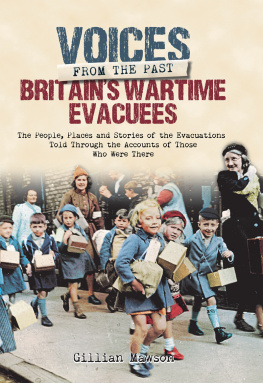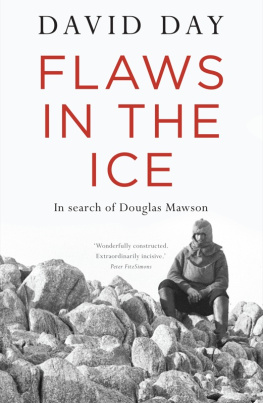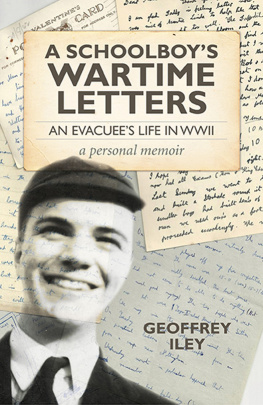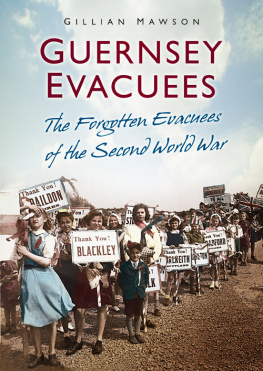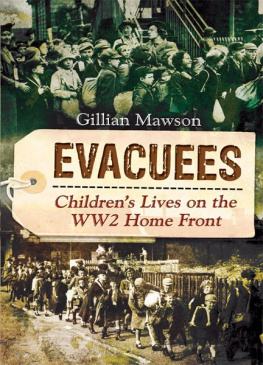
BRITAINS WARTIME EVACUEES
BRITAINS WARTIME EVACUEES
The People, Places and Stories of the Evacuations Told Through the Accounts of Those Who Were There
Gillian Mawson
Frontline Books
BRITAINS WARTIME EVACUEES
The People, Places and Stories of the Evacuations Told Through the Accounts of Those Who Were There
This edition published in 2016 by Frontline Books,
an imprint of Pen & Sword Books Ltd,
47 Church Street, Barnsley, S. Yorkshire, S70 2AS
Copyright Gillian Mawson
The right of Gillian Mawson to be identified as the author of this work has been asserted by her in accordance with the Copyright, Designs and Patents Act 1988.
ISBN: 978-1-84832-441-1
eISBN: 978-1-84832-443-5
Mobi ISBN: 978-1-84832-442-8
All rights reserved. No part of this publication may be reproduced, stored in or introduced into a retrieval system, or transmitted, in any form, or by any means (electronic, mechanical, photocopying, recording or otherwise) without the prior written permission of the publisher. Any person who does any unauthorized act in relation to this publication may be liable to criminal prosecution and civil claims for damages.
CIP data records for this title are available from the British Library
For more information on our books, please visit
www.frontline-books.com
email
or write to us at the above address.
Introduction
I n the early hours of 1 September 1939, the carefully devised British Government plans for evacuation swung into operation and millions of children, teachers and mothers began to be moved to safety. War was declared two days later.
More waves of evacuation started in May 1940, when fears of an invasion of Britain became very real. Air raids from German airships and bombers had left 1,500 British people dead during the First World War events which led the government to the assumption that, should another war occur, the loss of life from aerial bombardment would be extremely heavy. Evacuation plans needed to be made well in advance of any future war.
In April 1937, an event during the Spanish Civil War boosted Britains evacuation plans as German bombers conducted an air raid on the town of Guernica. In just one day, 1,654 adults and children were killed and 889 injured. Yet, even with carefully planned logistics surrounding the movement and housing of millions of British people, the psychological and lasting effects of evacuation on family life could never be planned for. Only by speaking to those who were actually involved and examining wartime reports can we discover the truth behind the evacuation experience. As a member of the British Evacuees Association, I feel it is vital that the memories of Second World War evacuees are recorded now before they are lost forever.
Since 2008 I have interviewed hundreds of evacuees from England, Northern Ireland, Scotland and Wales. Families have also given me access to the testimony of those who have passed away. I have organised evacuee reunions, provided research to radio and television documentaries on the subject of evacuation and run a community group for evacuees in Stockport. My first book, Guernsey Evacuees: The Forgotten Evacuees of the Second World War , told the story of the 17,000 individuals who fled Guernsey to the UK in June 1940, just days before their island was occupied by Germany for five years. My second book, Evacuees: Childrens Lives on the WW2 Home Front , shared 100 evacuation stories and family photographs. I have also interviewed those who, in 1940, found refuge in this country from Crown Dependencies such as Guernsey, Jersey, Alderney, and Sark, as well as the British Overseas Territory of Gibraltar, the majority of whom were certainly not sent to the safety of the countryside.
In this book I include stories from the mothers and teachers who travelled with the schoolchildren and took on a huge responsibility. We tend to hear their stories far less often than the stories of child evacuees. In some cases, schools were kept together as a unit, so the teachers became their pupils guardians for as much as five years, in a move unprecedented in educational history. These chapters include the difficult decisions made by the childrens parents and the administration behind the evacuation of schools. Evacuees describe their journeys to the reception areas and how they were actually treated upon arrival. Although most children journeyed by train, we also hear about the thousands who were evacuated by ship. Child evacuees describe their emotions while facing the selection process carried out by local people, whilst evacuated mothers with infants share traumatic memories of being separated from their own children.
Evacuees share their first impressions of their new homes, wartime foster parents and new cultures. Some stories shatter the myth that most city children left the slums for pristine homes in the countryside. Many were shocked when they were placed in country cottages with no running water, gas or electricity. Some householders simply refused to take in evacuees and were taken to court, whilst others tried to get rid of their evacuees within days of their arrival. A chapter is devoted to the kindness shown to evacuees from people in Britain and from overseas. However, another contains the tragic stories of evacuees who, having been sent to supposedly safe areas, were badly treated. They endured physical and mental cruelty and sexual abuse at the hands of their foster parents. It also contains details of the countless evacuees who died.
It would not be possible to paint a full picture of the evacuation experience without including testimony from the evacuees parents and their foster parents. Wartime letters written between evacuees and their parents and between the foster parents and the evacuees parents are also included here. They contain a wonderful mixture of everyday life, family affection and news of the war. They also give a glimpse into the relationships formed between children and their foster parents. The evacuees describe their emotions when they left their foster parents to return home. Many were delighted to be reunited with their own families whilst others had rather mixed feelings. For some, it was Evacuation all over again as they struggled to readjust to life with their own families. Mothers also had to be reconciled with their husbands after years apart. For various reasons, some evacuees never returned home. In the final chapter, evacuees look back, to share the aftermath of evacuation and the way this experience shaped their lives.
The personal testimony of hundreds of evacuees, together with the wartime reports and newspaper reports paint a true picture of wartime evacuation. The stomach-churning farewells, the fear and excitement, the adventures, the kindness and the cruelty. The breadth of experiences touched upon is extraordinary, along with what binds them: the evacuees incredible resilience and the willingness of the majority of people, from all walks of life, to do their bit. Whether they lived in a ramshackle country cottage with three kids to a bed and no running water, or a stately home; if they were teachers accompanying pupils from the Channel Islands or Gibraltar, only to be exiled from their own families for years; or volunteers for the Womens Voluntary Service and Salvation Army, it all goes to show that evacuation was a remarkable feat of organisation, dedication and sacrifice.
Next page
